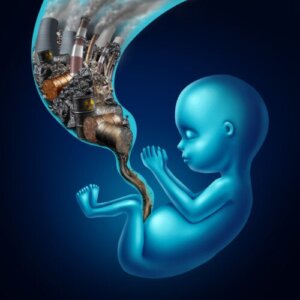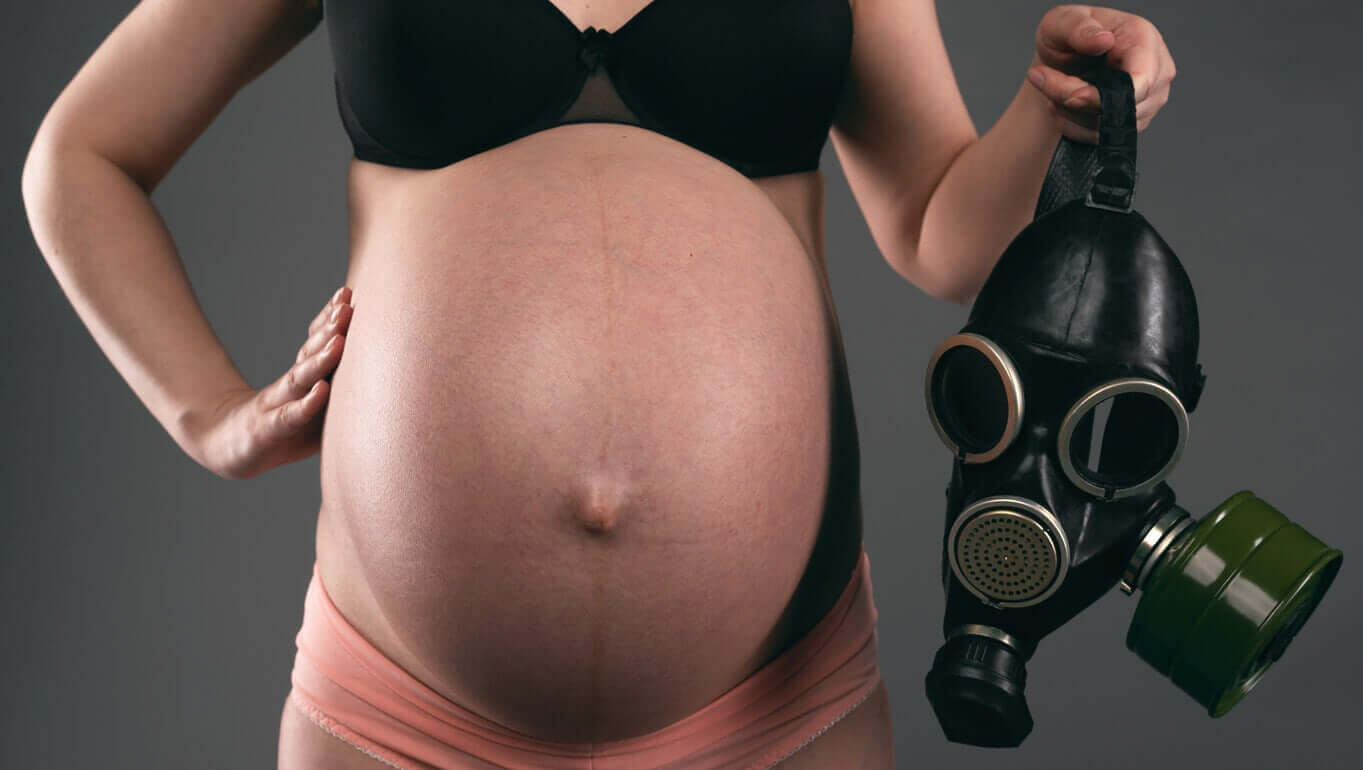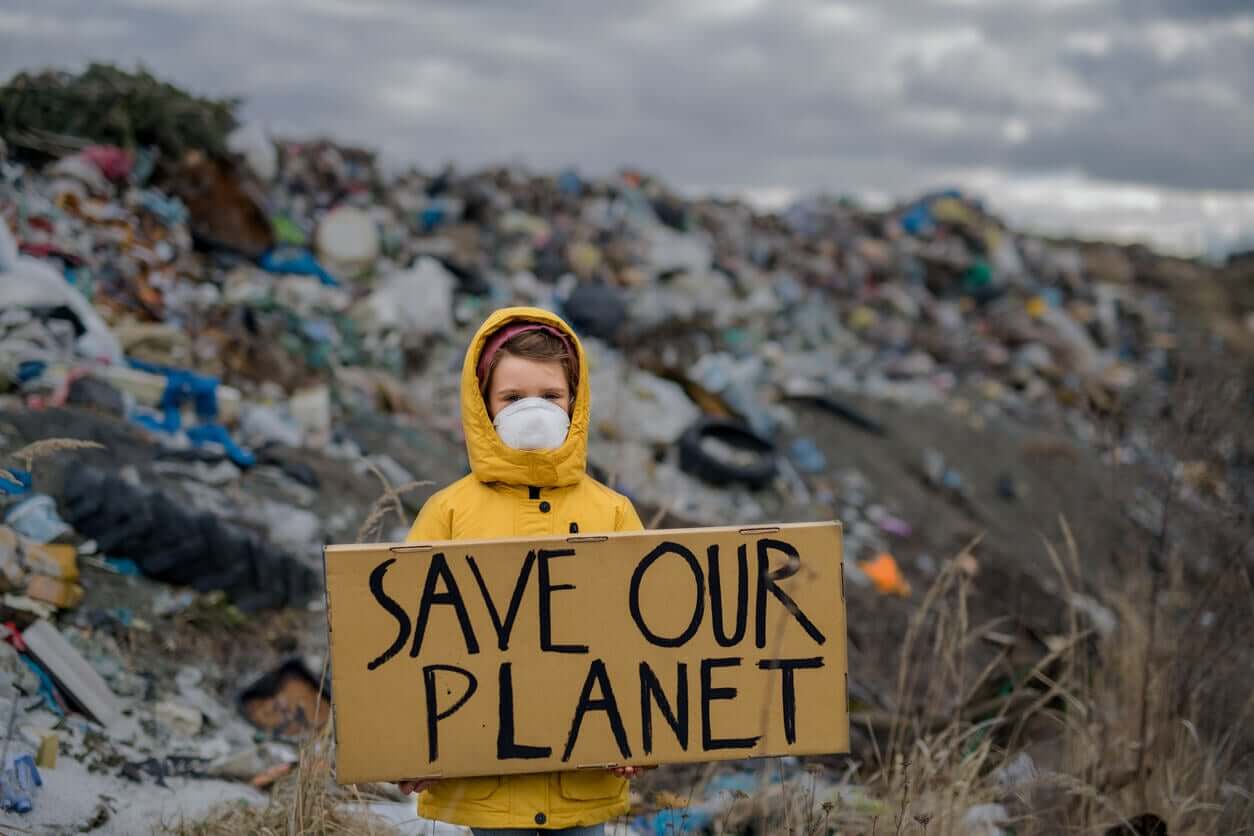Pollution Affects the Health of Newborns

Environmental pollution is a global problem, which does not discriminate borders, social status, or ages. However, some people are more vulnerable to its effects than others, such as pregnant women and their babies.
For several decades, scientists have demonstrated numerous associations between environmental toxins and certain pathologies. Among the most prominent obstetric consequences are premature birth, low birth weight, and perinatal death.
For this reason, it’s essential that you know how pollution affects the health of babies in order to prevent exposure to these harmful substances during pregnancy.
How does environmental pollution affect the health of mother and baby?
During pregnancy, the mother and fetus are permanently exposed to environmental toxins, both inside and outside the home.
As with passive smokers, the mother receives these substances through the respiratory tract with each inhalation. These are generally small enough to pass through your lung walls and directly into your blood.
The placenta is a highly irrigated organ and receives a large amount of maternal blood destined for the fetus. So, in addition to essential nutrients, the baby receives the toxins that circulate in the mother’s body and that couldn’t be eliminated.
As a consequence, the harmful effect of pollution affects them both.

You may be interested: 10 Tips to Quit Smoking If You’re Pregnant
The pregnant woman and the fetus: Two vulnerable organisms
Due to adaptive changes in gestation, women become particularly vulnerable to environmental toxins. Among them, we can mention the following:
- The increase in the surface area that the air receives in the lungs: This favors the entry of a greater amount of environmental toxins into the mother’s body.
- A natural tendency towards inflammation: Which increases the stress on cells and the production of their own waste substances.
- Decreased ability to get rid of these wastes: By remaining in the mother’s body, they break down and cause harmful elements, such as free radicals.
For its part, the fetus is in the process of developing its organs and every cell in its body multiplies at great speed. This increases the susceptibility to the aggressions of the environment and favors the appearance of malformations in any structure of the body.
The consequences of environmental pollution on the health of the newborn
Although there are many causes for the health problems that we’ll describe below, researchers are studying the direct association between these and environmental pollution.
Premature birth
Global warming and some environmental toxins seem to have a relationship with the risk of premature births, mainly in the warmer seasons of the year.
In turn, this risk appears to be even higher in African American mothers with a history of asthma or of low socioeconomic status. Therefore, it’s difficult to determine the actual causal relationship between contamination and premature birth.
Low birth weight
The WHO defines low birth weight as when the newborn weighs less than 2,500 grams at the time of leaving the maternal uterus. This problem affects more than 20 million babies in the world and its incidence is increasing day by day. Experts consider it one of the possible causes of this increase is pollution.
According to a recent longitudinal study carried out throughout the Spanish territory, there’s a direct association between exposure to certain environmental toxins and the risk of low birth weight. Among the substances researchers looked at are nitrous oxide, ozone, and solid particles called PM10.
Similarly, a systematic review published in 2020 in the journal JAMA determined the relationship between low birth weight and exposure to ozone, environmental heat, and solid PM2.5 particles. This study analyzed information from more than 32 million American newborns. In the end, researchers observed a significant increase in low weight after exposure to these toxins.
Perinatal death
Perinatal death refers to the death of a baby in the moments before, during, or after delivery. In the United States, the frequency is 1 in 160 births, and in 30% of cases, the cause can’t be determined.
Experts have linked this outcome to maternal exposure to environmental toxins, such as PM2.5 and ozone. According to the results of some studies, the risk of mortality from exposure to these toxins could be higher if it occurs during the third trimester of pregnancy.
Other problems in children’s health
Children with high exposure to environmental toxins during pregnancy are at greater risk of suffering from some of the following health conditions:
- Respiratory infections in early childhood
- Lung malformations
- Childhood asthma
- Changes in the structure of the cerebral cortex
- Arterial hypertension
- Cardiovascular disease in adulthood

You may be interested: Environmental Educational Activities for the Whole Family
Environmental pollution and the impact on human health
Year by year, the level of pollution increases. Until a while ago, this was a problem typical of large cities and developed countries, but today it affects everyone.
The physical damage that these toxins generate increases spending on health and environmental sanitation strategies. For this reason, authorities must give priority to health prevention campaigns.
It’s important to know that environmental pollution isn’t only on the outside of our houses, but also indoors. Therefore, women of childbearing age and pregnant women must receive appropriate counseling. This is the only way to preserve their health and that of their babies.
Environmental pollution is a global problem, which does not discriminate borders, social status, or ages. However, some people are more vulnerable to its effects than others, such as pregnant women and their babies.
For several decades, scientists have demonstrated numerous associations between environmental toxins and certain pathologies. Among the most prominent obstetric consequences are premature birth, low birth weight, and perinatal death.
For this reason, it’s essential that you know how pollution affects the health of babies in order to prevent exposure to these harmful substances during pregnancy.
How does environmental pollution affect the health of mother and baby?
During pregnancy, the mother and fetus are permanently exposed to environmental toxins, both inside and outside the home.
As with passive smokers, the mother receives these substances through the respiratory tract with each inhalation. These are generally small enough to pass through your lung walls and directly into your blood.
The placenta is a highly irrigated organ and receives a large amount of maternal blood destined for the fetus. So, in addition to essential nutrients, the baby receives the toxins that circulate in the mother’s body and that couldn’t be eliminated.
As a consequence, the harmful effect of pollution affects them both.

You may be interested: 10 Tips to Quit Smoking If You’re Pregnant
The pregnant woman and the fetus: Two vulnerable organisms
Due to adaptive changes in gestation, women become particularly vulnerable to environmental toxins. Among them, we can mention the following:
- The increase in the surface area that the air receives in the lungs: This favors the entry of a greater amount of environmental toxins into the mother’s body.
- A natural tendency towards inflammation: Which increases the stress on cells and the production of their own waste substances.
- Decreased ability to get rid of these wastes: By remaining in the mother’s body, they break down and cause harmful elements, such as free radicals.
For its part, the fetus is in the process of developing its organs and every cell in its body multiplies at great speed. This increases the susceptibility to the aggressions of the environment and favors the appearance of malformations in any structure of the body.
The consequences of environmental pollution on the health of the newborn
Although there are many causes for the health problems that we’ll describe below, researchers are studying the direct association between these and environmental pollution.
Premature birth
Global warming and some environmental toxins seem to have a relationship with the risk of premature births, mainly in the warmer seasons of the year.
In turn, this risk appears to be even higher in African American mothers with a history of asthma or of low socioeconomic status. Therefore, it’s difficult to determine the actual causal relationship between contamination and premature birth.
Low birth weight
The WHO defines low birth weight as when the newborn weighs less than 2,500 grams at the time of leaving the maternal uterus. This problem affects more than 20 million babies in the world and its incidence is increasing day by day. Experts consider it one of the possible causes of this increase is pollution.
According to a recent longitudinal study carried out throughout the Spanish territory, there’s a direct association between exposure to certain environmental toxins and the risk of low birth weight. Among the substances researchers looked at are nitrous oxide, ozone, and solid particles called PM10.
Similarly, a systematic review published in 2020 in the journal JAMA determined the relationship between low birth weight and exposure to ozone, environmental heat, and solid PM2.5 particles. This study analyzed information from more than 32 million American newborns. In the end, researchers observed a significant increase in low weight after exposure to these toxins.
Perinatal death
Perinatal death refers to the death of a baby in the moments before, during, or after delivery. In the United States, the frequency is 1 in 160 births, and in 30% of cases, the cause can’t be determined.
Experts have linked this outcome to maternal exposure to environmental toxins, such as PM2.5 and ozone. According to the results of some studies, the risk of mortality from exposure to these toxins could be higher if it occurs during the third trimester of pregnancy.
Other problems in children’s health
Children with high exposure to environmental toxins during pregnancy are at greater risk of suffering from some of the following health conditions:
- Respiratory infections in early childhood
- Lung malformations
- Childhood asthma
- Changes in the structure of the cerebral cortex
- Arterial hypertension
- Cardiovascular disease in adulthood

You may be interested: Environmental Educational Activities for the Whole Family
Environmental pollution and the impact on human health
Year by year, the level of pollution increases. Until a while ago, this was a problem typical of large cities and developed countries, but today it affects everyone.
The physical damage that these toxins generate increases spending on health and environmental sanitation strategies. For this reason, authorities must give priority to health prevention campaigns.
It’s important to know that environmental pollution isn’t only on the outside of our houses, but also indoors. Therefore, women of childbearing age and pregnant women must receive appropriate counseling. This is the only way to preserve their health and that of their babies.
All cited sources were thoroughly reviewed by our team to ensure their quality, reliability, currency, and validity. The bibliography of this article was considered reliable and of academic or scientific accuracy.
- Bekkar B, Pacheco S, Basu R, DeNicola N. Association of Air Pollution and Heat Exposure With Preterm Birth, Low Birth Weight, and Stillbirth in the US: A Systematic Review. JAMA Netw Open. 2020 Jun 1;3(6):e208243. doi: 10.1001/jamanetworkopen.2020.8243. Erratum in: JAMA Netw Open. 2020 Jul 1;3(7):e2014510. PMID: 32556259; PMCID: PMC7303808. Disponible en: https://www.ncbi.nlm.nih.gov/pmc/articles/PMC7303808/
- Inoue K, Yan Q, Arah OA, Paul K, Walker DI, Jones DP, Ritz B. Air Pollution and Adverse Pregnancy and Birth Outcomes: Mediation Analysis Using Metabolomic Profiles. Curr Environ Health Rep. 2020 Sep;7(3):231-242. doi: 10.1007/s40572-020-00284-3. Erratum in: Curr Environ Health Rep. 2020 Dec;7(4):441. PMID: 32770318; PMCID: PMC7599041. Disponible en: https://pubmed.ncbi.nlm.nih.gov/32770318/
- Steinle S, Johnston HJ, Loh M, Mueller W, Vardoulakis S, Tantrakarnapa K, Cherrie JW. In Utero Exposure to Particulate Air Pollution during Pregnancy: Impact on Birth Weight and Health through the Life Course. Int J Environ Res Public Health. 2020 Dec 1;17(23):8948. doi: 10.3390/ijerph17238948. PMID: 33271938; PMCID: PMC7730886. Disponible en: https://pubmed.ncbi.nlm.nih.gov/33271938/
- Arroyo V, Díaz J, Salvador P, Linares C. Impact of air pollution on low birth weight in Spain: An approach to a National Level Study. Environmental Research, 2019, 171, 69–79. doi:10.1016/j.envres.2019.01.030. Disponible en: https://pubmed.ncbi.nlm.nih.gov/30660920/
- Organización mundial de la salud. Metas mundiales de nutrición 2025: documento normativo sobre bajo peso al nacer. Año 2014. Disponible en: https://www.who.int/es/publications/i/item/WHO-NMH-NHD-14.5#:~:text=La%20Organizaci%C3%B3n%20Mundial%20de%20la,a%20corto%20y%20largo%20plazo.
This text is provided for informational purposes only and does not replace consultation with a professional. If in doubt, consult your specialist.








